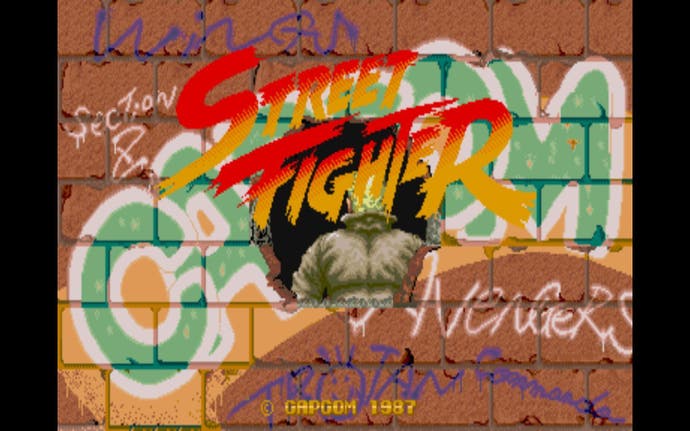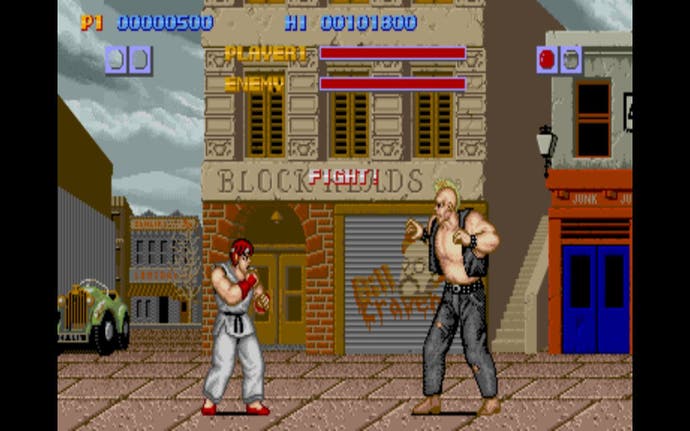Retrospective: Street Fighter
20 years of beat-'em-ups picked thoroughly apart.
Holy #*%$! I've just seen the Japanese intro for Street Fighter IV and it looks absolutely killer. Screw objectivity, I'm going to say right now that from my impressions of the Street Fighter IV arcade game and from what I've played so far of the console release, Street IV could very well be the greatest fighting game ever made. With Eurogamer's review going live tomorrow (Monday 16th February), I'm taking a look back at the different Street Fighter games in their many different arcade transitions. Hold onto your sticks people.
Series by series
Street Fighter
Series:
(1987) Street Fighter
SFI Mechanics:
- Shotokan - the classic Hadoken, Shoryuken and Tatsumaki Senpukyaku moveset
- Specials - the three examples listed above
The first ever Street Fighter appeared in arcades in 1987 and was directed and produced by Takashi Nishiyama and Hiroshi Matsumoto, who would later leave Capcom to work for SNK and produce some of Street Fighter's biggest rivals - including Fatal Fury and The King of Fighters. The original Street Fighter offered arcade patrons a fighter experience that was visually far more impressive than Yie Ar Kung Fu or Karate Champ, although the 2D animation, even compared to the first Street Fighter II, is choppy to say the least.
Players didn't have any choice in character selection; Player 1 was Ryu and Player 2 was Ken (if you've briefly played Super Street Fighter II Turbo HD Remix online you'd be forgiven for assuming this is a tradition Capcom never dropped). If Player 2 won against Player 1 it was possible for them to complete the rest of the game as Ken. Although considerably more fleshed out in later iterations, Ryu's initial story didn't go much further than entering a mixed martial arts tournament to prove his strength (and no doubt honour).

Before the first fight the player had the option of whether they wanted to start their world tour in Japan, the United States, China or England. Each country housed two Street Fighting champions who had to be toppled in the classic best-of-three-rounds format before moving onto the next pair. Seems us Brits have the poorest street-fighting output, with crude bouncer Birdie and the camp, club-wielding Eagle, each named after golf terms. Thailand, however, the final fifth country after the other four have fallen, is home to the superlative Muay Thai Emperor Sagat and his protégé Adon.
Out of the twelve original Street Fighter cast, over half were brought back in later games. Ryu, Ken and Sagat made obvious returns, and Birdie, Adon and Gen all resurfaced in the Street Fighter Alpha series. Eagle, meanwhile, got a lucky break when he was exhumed for Capcom vs. SNK 2. However, generic ninja Genki and underground martial arts champion Joe will likely never be heading the bill for a comeback fight. Character design has moved on considerably.
Similar to the barrel-breaking and car-crushing bonus games of Street Fighter II, Street Fighter preceded its older brother with board- and block-breaking bonus games spliced in-between the bouts. Hearing the crowd boo Ryu after he fails to break a few flimsy boards raises a smile when you consider that some of his Marvel vs. Capcom Supers could probably level a house. Seems his years of training really paid off.
Last year one of our number had a heated discussion with a fellow Street Fighter fan about the first Street Fighter's control system. He was convinced that the cabinet had a joystick and a pressure-sensitive punch and kick button, which, depending on how hard it was pressed, would result in either a light, medium or heavy attack. Conversely his friend was adamant that the original Street Fighter had the same six-button interface as the subsequent Street Fighter II games.

It turns out they were both right. Street Fighter was sold in a regular six-button cabinet and a deluxe cabinet that utilised pressure-recognition technology. Reports suggest that the pressure buttons were gimmicky at best, susceptible to breaking and made the game harder to play. But we'd wager that a pristine Street Fighter Deluxe cabinet will be a desirable piece for any Street Fighter memorabilia collector.
In gameplay terms, time hasn't been kind to Street Fighter in the same way it has to Street Fighter II. Everything feels imprecise with erratic animation and timing; some bouts can be over in seconds. The classic shotokan moveset of Fireball, Dragon Punch and Hurricane Kick are available to Ryu, even though Capcom left it for players to discover them by themselves rather than including the movelist on the cabinets. The timing for these specials was less forgiving than Street Fighter II, but if you could pull them off most opponents could be downed in two or three hits. Not even Super fireballs can do that these days.
It's common knowledge among fighter fans that Ryu gave Sagat the scar on his chest with a fierce Dragon Punch at the end of the first Street Fighter tournament. We don't know how he lost the eye though - maybe there's a Black Mamba fighter Capcom still hasn't unveiled yet. Those who managed to finish Sagat were rewarded with a message. "There is always someone waiting in line to knock you off the top, be prepared to be challenged." Capcom's future interpretation of this would change the fighter scene forever.

